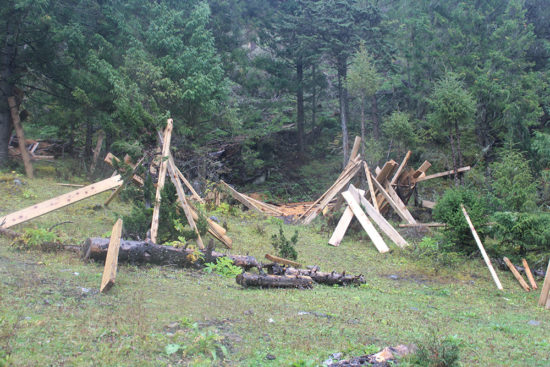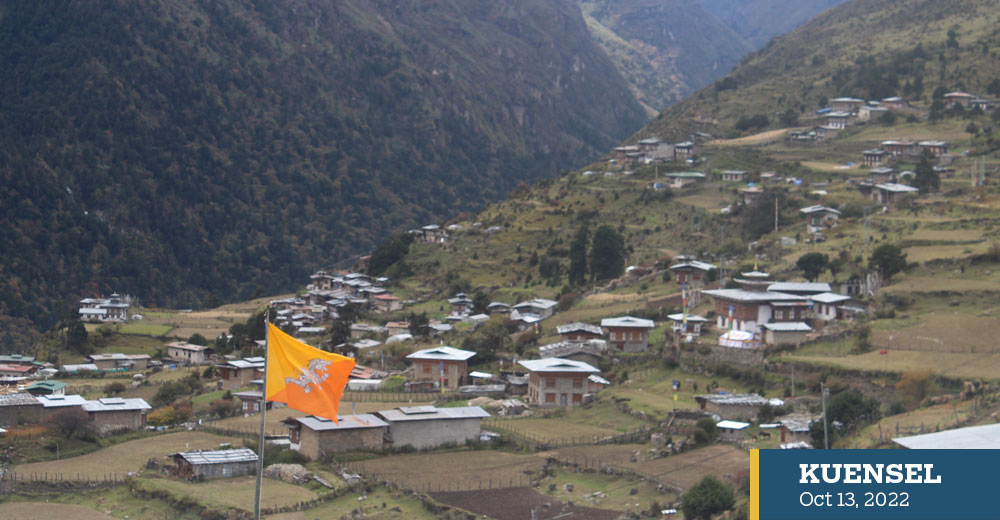… efforts are underway to help forests recover
Thukten Zangpo
The prosperity of residents in Laya, a remote hamlet in Gasa dzongkhag, has carved a deep scar on their natural environment and is changing the landscape of their habitat. Some elders and foresters worry about the ominous signs that are becoming starker each year.
Ap Passang, 64, from Chongra in Laya gewog recalls gathering firewood and timber in a day a few years ago. Today, it takes at least two. “Sometimes even three.”
Residents said that the population in the gewog has been increasing annually. There are about 267 households in the gewog.
“When the Layaps turn 18 years, they become eligible for cordyceps collection and then they construct houses from the income,” Ap Passang said.
Layaps thrive mainly on income from cordyceps collection. They also rear yaks and collect incense shrubs they sell in winter when they migrate to warmer valleys.
Before cordyceps collection was legalised in 2004, Ap Passang said that the villagers’ depended on a small quantity of illegally-collected cordyceps, incense and medicinal herbs.
Foresters in the area said that the area has seen forest fragmentation because of the Gasa to Laya road construction, and power transmission lines.
The electricity came to Laya in 2016. The following year, the construction of the 26 kilometers road from Gasa to Laya began. It has reached Tongchudrak. From there it is a four-hour walk to Laya. Before the road came, it was a two-day journey on foot from the dzongkhag headquarters in Gasa to Laya.

Commercial timber extractions almost doubled in last one year
As per the record with Jigme Dorji National Park (JDNP), Laya falls within the park, residents felled 18,321.74 cubic feet (cft) of commercial timber and 11,393.52cft of rural timber in 2021.
Senior forester of JDNP in Laya, Norbu Dorji said that usually 10,000cft of commercial timber is harvested in a year, mostly conifer trees.
He added that harvesting timbers, especially conifer trees in the area could be a threat. “Conifer trees take 100 years to regenerate.”
A senior forestry officer of JDNP, Rinzin Dorji said that mountainous areas are fragile and trees act as agents that hold the soil and water. “From the conservationists’ view, the open area and the forested area should be proportionate.”
However, he added that currently, the park is focused on afforestation because of the high chances of forest degradation. The park planted 1,500 trees in Laya as of 2018.
Rinzin Dorji claimed that the treeline might have gone up because of lots of conservation efforts and awareness or because of climate change.
The Ugyen Wangchuck Institute for Conservation and Environment Research is going to conduct a study on the treeline this year.
Norbu Dorji said that the growing of broadleaved trees at the higher altitude could degrade native species like conifer and fir. “In place of fir trees at altitudes of 3,700m to 3,800m, more spruce and blue pines are creeping up to higher altitudes.”
He attributed the increasing incidents of human-wildlife conflicts (HWC) to human activities such as felling timbers at the prime wildlife habitats with increasing housing constructions.
Human-Wildlife Conflict
Gewog livestock extension officer, Jigme Rinzin said that the snow leopard is a main predator for the yak herders. “Every year, they attack about 100 yaks and kill about 50.”
There are also attacks from Himalayan or Asiatic bears, Tibetan foxes, and wild dogs. In the first week of October, there were six Himalayan bear attacks.
JDNP records show that 36 yak, 11 mules, and five horses were attacked between 2018 and 2020. Data before that period was unavailable.
He said that the Himalayan bears usually attack houses that are on the outskirts of the village or empty homes when villagers set out to collect cordyceps or migrate to lower valleys in winter. There are two to three cases of homes damaged every year.
To mitigate HWC, electric fencing and solar lighting were provided to the herders.
Jigme Rinzin said that because of the warmer climate, there has been an increase in the forage or biomass in higher altitudes because of changes in rainfall patterns. There has been a delay in the herding pattern too.
“Earlier the herders migrate to lower valleys before the blessed rainy day (September 23). Now they migrate after that day,” Jigme Rinzin said.
He also said that ticks were found in yaks in winter. “Ticks are usually dormant in the cold winter.”
Norbu Dorji said that they recorded 204 Takins in 2011, the highest number recorded in Tshari Jathang in Laya, which is their summer habitat. Today, they could spot a few. “The construction of a road from Gasa to Laya has disturbed the takins’ migratory route near Koina.”
“With the developmental activities like road construction, there are high chances that the native species would be extinct in near future,” Norbu Dorji said.
A yak herder, Phub Tenzin from Toedkar in Laya, who herds his yaks two days away in Tshari Jathang said that climate change is happening. “We’re receiving heavy snowfall now compared to some years ago.”
Similarly, he said the rainfall now is shorter and heavier compared to light and continuous a few years ago.
“When there is heavy snowfall for about 4 to 5 days, we are unable to get grass for the yaks, ‘’ Phub Tenzin said.
He claims that because of the corrugated galvanised iron (CGI) sheet roofing the houses and the advent of electronics, the place has become warmer.
To safeguard the forests, he said that unlike in the past, now the gewog committee would verify if there is a genuine need for timber. Earlier, the households were entitled to commercial timber after every 12 years.
Laya gewog mangmi, Pema Jamtsho said that since last year, an individual can construct only one house and not two to three like before.
As per the non-wood forest products’ management plan, the forest department has allowed villagers to collect 20 kilograms of Pangpey a year.
Norbu Dorji said that by November this year, the villagers would not be able to get commercial timber from any location they choose.


